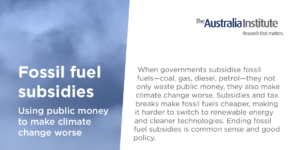by Richard Denniss
[Originally published in the Financial Review, 19 Feb 2019]
Millions of people in developing countries jumped straight from having no phone to having a mobile phone and so too will thousands of villages in developing countries jump from having no grid electricity to their own renewable energy. Leapfrogging old technologies can save billions.
But here in Australia, where we try to use a copper network to deliver broadband internet, obvious solutions seem a world away. It’s as if we think that because we had to go through the dirty and expensive stages of industrial development, everyone else should, too.
Back in 1971, when TVs were black and white and coffee came only in tins, the NSW government built the Liddell power station. Its inland location meant millions of tonnes of coal could come straight from nearby mines on a conveyor belt, significantly reducing the cost of electricity. But 48 years later, Liddell’s now private owners think that even though they own land on top of one of the world’s biggest coal seams, it makes more economic sense to replace their ageing steam engine with new sources of renewable energy and battery storage.
Privately owned electricity generators in Australia don’t want to invest billions of dollars in new coal-fired power plants for the simple reason that renewable power with storage is cheaper and quicker to build. The idea that it doesn’t make sense to place a 50-year bet on coal-fired generation in Australia, but it does in developing countries, is simply bizarre.
If AGL, the largest consumer of coal in Australia, can’t make coal-fired powered stations stack up financially — even with near zero coal transport costs — how can anyone believe that coal will make sense in developing countries that have to cover all of the costs of getting their coal from Australia to Asia?
Boosters of coal in Australia often talk about the “pipeline” of coal-fired power stations being planned or built across Asia as undeniable proof of the future demand for coal. But just because something gets built doesn’t mean it will be used for the next 50 years. VCR factories and photo development labs didn’t close due to old age. Indeed, while much has been made of all of the investment in Chinese coal-fired power stations, the fact is the average Chinese coal-fired power station now runs for less than 12 hours per day.
It’s true that coal will play a significant role in the generation of electricity for decades to come. But that role will continue to decline steadily for the simple reason that the cost of competing sources of energy keeps falling. And just as people won’t wait for their petrol cars to break down before switching to electric vehicles, electricity companies won’t wait until the boilers on their coal-fired power stations wear out before they switch to lower-cost renewables. Markets are funny like that.
But the conservative side of politics doesn’t care as much about markets as it once did. Arguably, coal has done more to harm Australian conservatives’ faith in markets than anything else. Whether it’s subsidies or “big stick” regulations to punish companies that won’t invest in coal-fired power, for the modern conservative when it comes to coal, government intervention is a good idea.
While concern about climate change is one reason to be bearish about the outlook for coal, it is by no means the only one, or even the most pressing. Concerns about air quality are driving the Chinese and South Korean governments to burn a lot less coal and there is no doubt that densely populated India is beginning to confront the political and health costs of coal smog. Then there’s the fact renewable energy works at small-scale and doesn’t need massive upfront investments in transmission and distribution grids.
While the conservative side of politics has a long and successful track record of beating environmentalists in political battles, it has a lot less experience fighting against market forces. It’s true that some new coal-fired power stations will be built in other countries in the coming years, but most of those investment decisions are being made by bureaucrats in state-owned energy companies while the private sector in Australia is betting on renewables. The fact that so many Australian conservatives are backing foreign bureaucrats over market forces suggests it’s not just the atmospheric climate that is changing.
Richard Denniss is chief economist at The Australia Institute @RDNS_TAI. His new book, Dead Right: How Neoliberalism ate itself and what comes next, is avaiable now.
Between the Lines Newsletter
The biggest stories and the best analysis from the team at the Australia Institute, delivered to your inbox every fortnight.
You might also like
Should Australia ban fossil fuel advertising?
A tobacco-style ban on fossil fuel advertising would be a decisive win for Australia – and the climate.
Fossil fuel subsidies
When governments subsidise fossil fuels—coal, gas, diesel, petrol—they not only waste public money, they also make climate change worse. Subsidies and tax breaks make fossil fuels cheaper, making it harder to switch to renewable energy and cleaner technologies. Ending fossil fuel subsidies is common sense and good policy.
Can you imagine any other climate research group asking for less money?
Getting coal for Christmas is supposed to be a bad thing. But for Australia’s coal mines, all their Christmases seem to have come at once!



